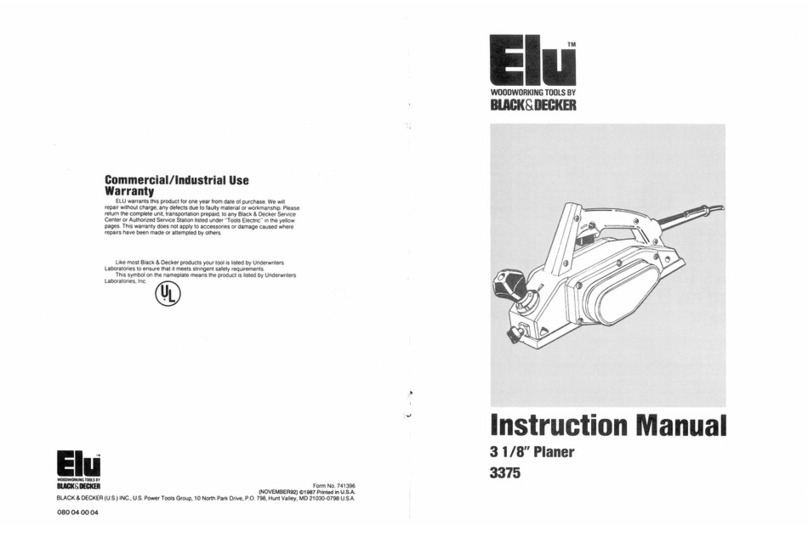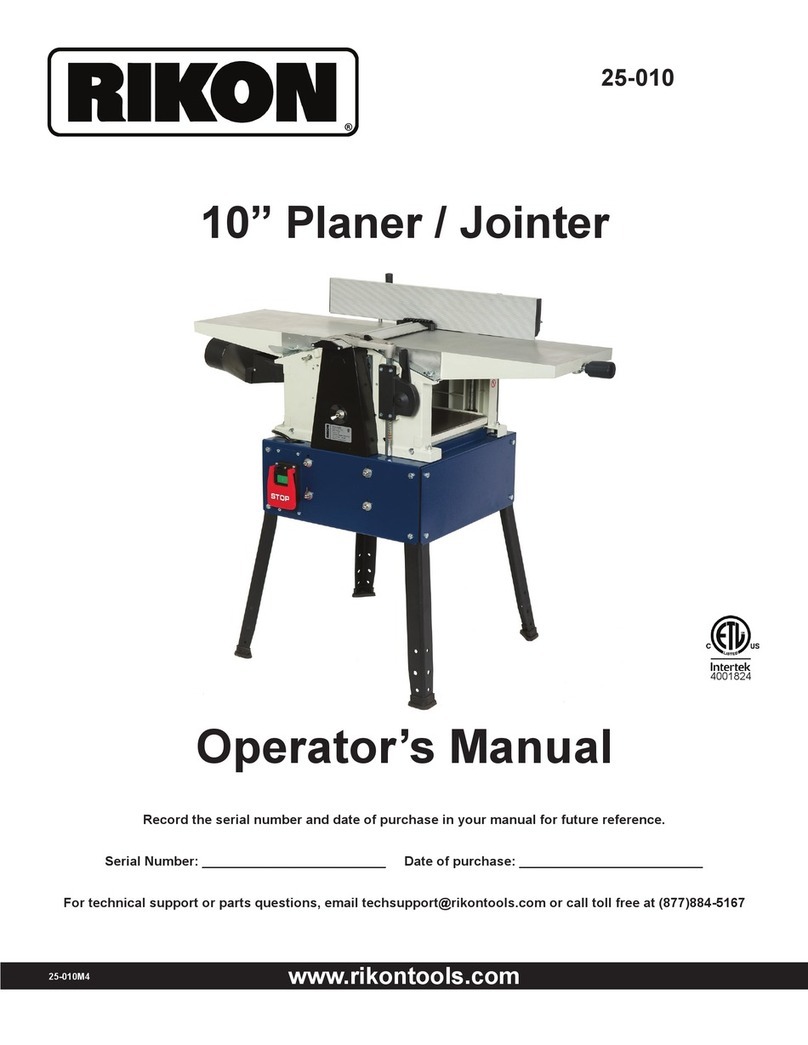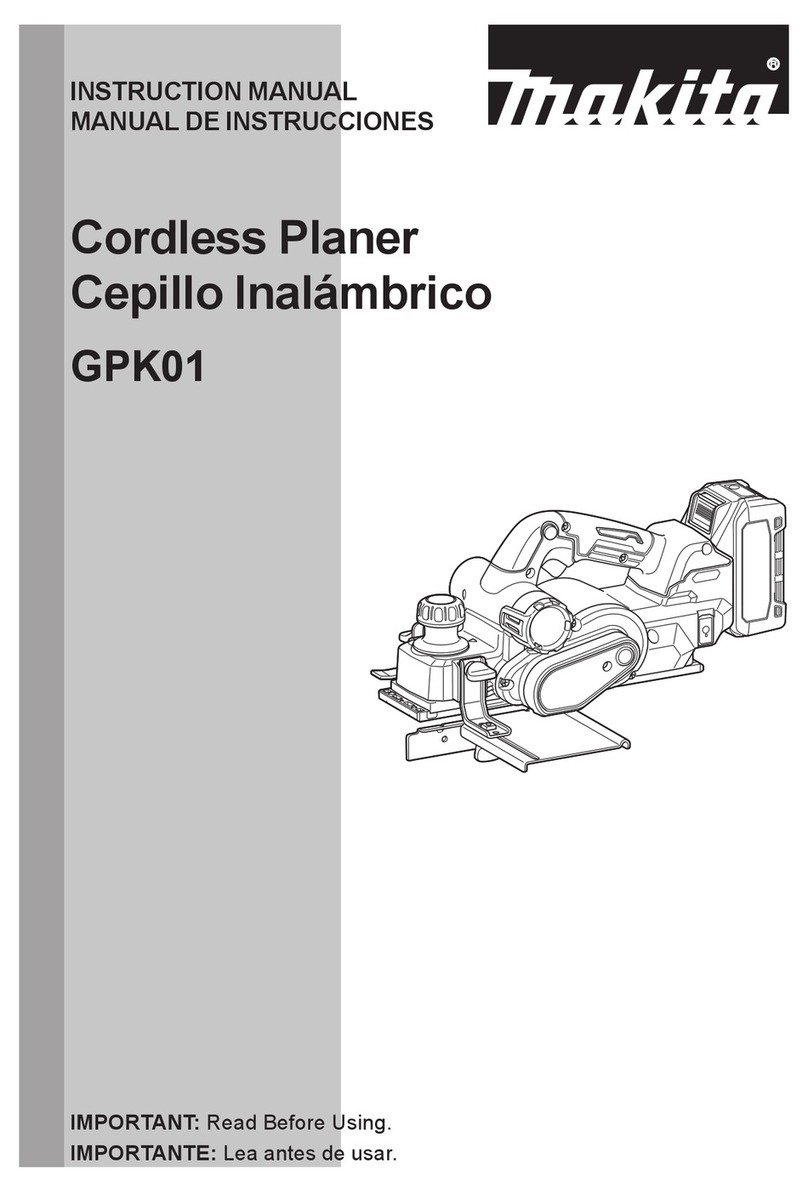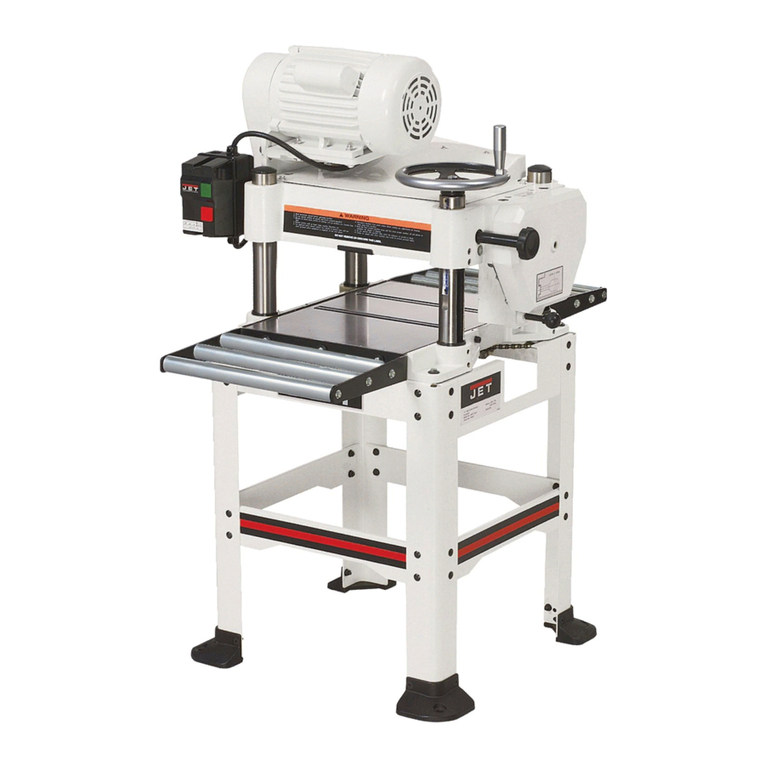Trelawny TFP200 Troubleshooting guide

TFP200 FLOOR PLANER
OPERATION & MAINTENANCE

OPERATION
Foreword
Thank you for your purchase of the TRELAWNY
TFP200 Floor Planer.
This manual contains the necessary maintenance
information for you to ensure proper operation and
care for this machine.
See also the manual that is supplied by the
engine manufacturer.
It is essential for you to read through these
manuals thoroughly.
In the unlikely event that you experience problems
with your TFP200, please do not hesitate to contact
your local Trelawny dealer or agent. We always
welcome feedback and comments from our valued
customers.
General Information
Before operating, performing maintenance or
repairing the TFP200 Floor Planer this manual must
be read and understood by the operator, if in any
doubt, ask your supervisor before using this
equipment.
Local safety regulations must be followed at all
times. Failure to follow these instructions could result
in damage to the TFP200 and/or personal injury.
Trelawny SPT Limited disclaims all responsibility for
damage to persons or objects arising as a
consequence of incorrect handling of the machine,
failure to inspect the machine for damage or other
faults that may influence the operation prior to
starting work, or failure to follow the safety
regulations listed or applicable to the job site.
This machine is primarily designed for the removal of
paint, heavy rust, scale and for the removal of
laitance from concrete from floor areas. It can be
used both indoors and out. Electric and compressed
air models are more suitable for indoor use because
of the toxic gases that are produced by petrol
engines.
Air Supply
(Air Motor Versions)
The compressed air must be free from water and
dirt. The installation of a filter/regulator/lubricator air
preparation set (with moisture trap) adjacent to the
tool is strongly recommended.
Always clear the air hose before connecting to the
tool. Ensure that no moisture (condensation) is
present in the air hose.
Ensure that a minimum 19mm (3/4”) bore air hose is
used and that all couplings are secure, leak free and
in good condition.
Limit the length of air hose to 30M (100ft). Where
extra length is necessary, for each additional 15M
(50ft) of air hose used, the pressure drop is
approximately 0.21bar (3psi).
For safe and efficient operation the correct
operating pressure is 6.2bar (90 psi).
Do not let the operating pressure fall below 5.5bar
(80p.s.i.) or rise above 6.9bar (100 psi).
Preferably, the compressor should be able to supply
a minimum of 95 L/s (200 cfm) free air.
In particularly cold weather it is recommended that a
proprietary anti-freeze lubricating oil is used.
Safety
WEAR SAFETY BOOTS, FACE MASK,
SHATTERPROOF GLASSES, HELMET,
GLOVES and any other personal protective
equipment required for the working conditions.
Avoid loose clothing; this may become trapped
in moving parts and cause serious injury.
TO AVOID NUISANCE DUST, connect an industrial
vacuum cleaner (minimum 3000watts or
equivalent) to the 50mm (2”) vacuum port
situated at the rear of the machine.
ENSURE THAT THE WORK PLACE IS WELL
VENTILATED. Avoid operating engine-
powered machines in an enclosed area, since
engine exhaust gases are poisonous.
BE VERY CAREFUL WITH HOT COMPONENTS.
Exhausts and other parts of the engine are hot
during operation and can remain hot for some
time after shutdown.
DO NOT REFUEL THE ENGINE WHILE THE
ENGINE IS HOT OR RUNNING, there is a
very real danger from explosion –always
refuel when the engine is cold, and in the open
air.
During transportation fasten fuel cap tightly and
close fuel cock.
DO NOT carry out any work on this machine without
disconnecting it from its air or electrical power
supply.
CAUTION THIS MACHINE IS HEAVY. It weighs
around (Wt 73 kg (161 lbs)) dependent on
power unit. Do not lift this machine manually.
IMPORTANT:
When fitted with a petrol engine, AVOID TIPPING
THE TFP200 BACKWARDS, especially when hot;
the engine oil can run past the piston and into the
combustion chamber causing the piston to “hydraulic
lock” when next attempting to start the engine. Never
attempt to forcibly turn the engine over if this has
taken place, severe damage to the engine can be
caused, resulting in a costly major strip down and
possible injury to the operator.
To remove any oil from the cylinder, first remove the
spark plug and place a lint free cloth over the
plughole to capture the jettisoned oil. Turn the
engine over with the ignition switch and fuel cock in
the off position and expel as much of the oil as
possible. Clean the spark plug to remove oil from the
electrodes and replace. The plug may have to be
removed and cleaned several times before the
engine will start. Upon starting, the engine may
produce smoke for a while from the exhaust, but this
should soon clear.
Finally stop the engine and recheck the engine oil
level. (Ensure that the engine is level prior to
carrying out this check). If the engine oil level is low,
refill with the recommended motor oil - see engine
manufacturers operating instructions.
Risk of Hand-arm
Vibration injury
These tools may cause Hand-arm Vibration
Syndrome injury if their use is not adequately
managed.
We advise you to carry out a risk assessment and to
implement measures such as; limiting exposure time
[i.e. actual trigger time, not total time at work], job
rotation, ensuring the tools are used correctly,
ensuring the tools are maintained according to our
recommendations, and ensuring that the operators
wear personal protective equipment [PPE]
particularly gloves and clothing to keep them warm
and dry.
Employers should consider setting up a programme
of health surveillance to establish a benchmark for
each operator and to detect early symptoms of
vibration injury.
We are not aware of any PPE that provides
protection against vibration injury by attenuating
vibration emissions.
See ‘Specifications’ section for vibration
emission data.
Further advice is available from our Technical
Department.
We strongly advise you to visit the Health & Safety
Executive website http://www.hse.gov.uk/vibration
This site provides excellent advice and information
on HAV and currently, includes a Hand-arm
Vibration Exposure Calculator that is easy to use to
work out the daily vibration exposure for each of your
operators.
Cutter types &
Applications
T.C.T
Hardened steel cutter with tungsten carbide inserts.
For all general cleaning applications, including
concrete texturing, Scabbling, the grooving of
concrete, removal of embedded roof chippings,
brittle coatings from steel work. Use TCT Cutters on
heavy applications, for longer life and higher output.
Produces “tramlines” on concrete and small
indentations on steelwork.
STAR
Heat-treated steel cutters used for the aggressive
removal of paint and coatings from floor areas, but
with a shorter life span than Beam Cutters. Can be
used for the general removal of dirt and ice deposits
and to produce a texture on concrete surfaces.
Produces roughened surface on concrete and light
marking on steelwork.
BEAM
Heat-treated steel cutters used for the removal of
paint and coatings from floor areas, but with a
shorter life span that TCT Cutters, not as aggressive
as Star Cutters. Can be used for the general removal
of dirt and ice deposits. Produces a fine texture on
concrete surfaces and slight marking on steelwork.
MILLING
Flat tungsten carbide cutters for the removal of
thermo-plastic road and runway markings. Very
efficient and cost effective with none of the problems
associated with burning off. These can also be used
for the removal of bituminous and rubber deposits.
Very effective for the removal of two part epoxy floor
paint, may require finishing with beam cutters or the
Trelawny floor grinder to achieve the required finish.
Note: Care must be taken with milling cutters to
ensure that the Drum and its Cutters are is fitted the
correct way round, the tungsten carbide tips must
face towards the vacuum port at the bottom as the
drum rotates, otherwise the tips will be damaged in
use. Produces a “strip” on concrete and tarmac, is
not recommended on steelwork unless for “braking
up” coatings.
NB: Increasing or decreasing the number of spacers
used can alter the performance and finish
characteristics of each cutter type. Ensure that the
same type and quantity of spacers and cutters are
fitted to the opposite cutter shaft to maintain the
drums balance. An out of balance drum can be very
dangerous and will also dramatically increase the
vibration emissions.
Changing Cutter Drums
Turn off and stop the machine, making sure the
cutter drum has come to a complete standstill.
If electric or air powered, disconnect the
machine from the power source.
Adjust the height adjustment hand wheel so that the
cutters are clear of the ground.
Remove the four Side Plate retaining bolts and
remove the Side Plate. If the Side Plate is stuck in
it‟s opening or on the dowel pins, use two of the Side
Plate retaining bolts inserted into the threaded holes
on each side of the Side Plate. Screw in both of
these bolts equally until the Side Plate is free.

MAINTENANCE
With the Plate removed the Cutter Drum will simply
slide off the Drive Shaft. The fitting of the drum is
basically the reverse of the removal procedure.
When changing cutter drums always check that the
flail shafts are not excessively worn with pronounced
grooves, also that the centres of the cutters and
spacers and check that the drum flail shaft location
holes are not elongated. The screws which hold the
drum end plates in position must be tight and in good
condition.
Note: In general use it is expected that normally two
sets of flail shafts will be used to one set of TCT
cutters. While changing the drum the condition of the
drive shaft, the drum‟s hexagon drive, the drive shaft
bearings and side plate bearing should be checked.
If any roughness, side play or leakage of grease is
detected then new bearings should be fitted. Lightly
oiling the drive shaft will prevent a build up of rust,
which could cause difficulty when changing the drum
later. While the Drum is removed, check that the
vacuum port is free from blockages and that the
wear strip, which also retains the dust skirt are both
in good condition. Replace any damaged, worn or
suspect parts. Ensure that all the bolts are tight at all
times, recheck at regular intervals.
Cutter Replacement &
Configurations
Replacing cutters/spacers/flail shafts
Remove Drum; see Changing Cutter Drums.
Unscrew the four countersunk screws and locknuts
from either end of the Cutter Drum.
Using a suitable drift, push out each of the flail
shafts. Check each of the flail shafts for wear and
replace as required. Check also the Drum, Cutters
and Spacers for elongation and hole enlargement,
replace as necessary.
See the table below for the examples of the
sequence of spacers /cutters for each style of drum.
Before loading any cutters, establish which is
“Position 1”. (See next)
Position the two shorter rows to the left and at the
top as you look at the drum; identify the short row on
the left furthest away from you (at the “back” of the
drum), this is “Position 1”
For ease of assembly, mark the end of the drum to
help identify each flail shaft, rotate the drum away
from you marking each position in order. 1,2,3,4.
The drum’s web plate thickness and positions
can vary slightly; because of this, the quantity of
cutter and/or spacers may need to be adjusted,
ensure that the same amount of cutters and
spacers are fitted to opposite shaft to keep the
drum balanced. These examples are for
illustrative purposes only.
Method as per Single Web Drum;
Insert a flail shaft into the drum from the left side, in
position 1, so that its end is in the middle of the short
row, start to load with a single spacer first, fit the 9
cutters alternating with a spacer until the last cutter,
pushing the fail shaft further through as the shaft fills,
in this case end the short row with 1 single spacer.
Continue with the long row on the same shaft, but no
spacer is fitted before or after the last cutter (See
example below)
Rotate the drum away from you to complete shaft
2,3 and 4.
Finally secure the end plates with the four
countersunk screws and four new locknuts.
Example for Position 1: - (Short Row) 1 x spacer,
followed by 9 x cutters and with a single spacer after
each cutter, but ending with a single spacer after the
last cutter. Continue with the long row, no spacer,
followed with 12 x cutters with a single spacer after
each cutter, ending with no spacer after the last
cutter.
Milling Cutter Single Web Drum (Economy load)
Example for Position 1: - (Short Row) 4 x spacers, followed by 1 x cutter, then 6 x spacers, followed by 1 x cutter, ending with 5 x
spacers, continue with the long row, 4 x spacers followed with 1 x cutter, then 8 x spacers followed by 1 x cutter ending with 9 x
spacers.
TCT CUTTERS FITTED TO SINGLE WEB DRUM
Position Short Row Left
Centre
Web
Long Row
1 1sp-9c-1sp 0sp-12c-0sp
2 2sp-9c-0sp 1sp-11c-2sp
Long Row Right
Centre
Web
Short Row
3 0sp-12c-0sp 1sp-9c-1sp
4 2sp-11c-1sp 0sp-9c-2sp
TCT CUTTERS FITTED TO DOUBLE WEB DRUM
Position Left Row
Left
Web
Middle Row
Right
Web
Long Right Row
1 0sp-6c-0sp 0sp-6c-0sp 0sp-8c-1sp
2 2sp-5c-1sp 1sp-5c-2sp 1sp-8c-0sp
Long Left Row
Left
Web
Middle Row
Right
Web
Right Row
3 1sp-8c-0sp 0sp-6c-0sp 0sp-6c-0sp
4 0sp-8c-1sp 2sp-5c-1sp 1sp-5c-2sp
MILLING CUTTERS FITTED TO SINGLE WEB DRUM (Standard load)
Position Short Row Left
Centre
Web
Long Row
1 1sp-1c-1sp-1c-2sp-1c-1sp 1sp-1c-3sp-1c-3sp-1c-6sp
2 1sp-1c-2sp-1c-1sp-1c-1sp 6sp-1c-3sp-1c-3sp-1c-1sp
Long Row Right
Centre
Web
Short Row
3 6sp-1c-3sp-1c-3sp-1c-1sp 1sp-1c-2sp-1c-1sp-1c-1sp
4 1sp-1c-3sp-1c-3sp-1c-6sp 1sp-1c-1sp-1c-2sp-1c-1sp
Milling Cutter Single Web Drum (Full load)
Example for Position 1: - (Short Row) 3 x full milling cutters, followed by 1 x ½ size milling cutter, continue with the long row, 4 x full
milling cutters, followed by 1 x ½ size milling cutter.
MILLING CUTTERS FITTED TO SINGLE WEB DRUM (Full load)
Position Short Row Left
Centre
Web
Long Row
1 0sp-3c-½c-0sp 0sp-4c-½c-0sp
2 0sp-½c-3c-0sp 0sp-½c-4c-0sp
Long Row Right
Centre
Web
Short Row
3 0sp-½c-c4-0sp 0sp-½c-3c-0sp
4 0sp-4c-½c-0sp 0sp-3c-½c-0sp
Milling Cutter Double Web Drum
Example for Position 1: - (Left Row) 6 x spacers, followed by 1 x full cutter, ending with 6 x spacers, continue with the (Middle
Row), no x spacer, followed by 1 x full cutter, then 3 x spacers, then 1 x full cutter ending with no spacers, continue with the (Long
Right Row), 3 x spacers, followed by 1 x full cutter, then 1 x half cutter, followed by 1 x full cutter, finishing with no spacer.
MILLING CUTTERS FITTED TO DOUBLE WEB DRUM
Position Left Row
Left
Web
Middle Row
Right
Web
Long Right Row
1 6sp-1c-6sp 0sp-1c-3sp-1c-0sp 3sp-1c-½c-1c-0sp
2 0sp-1c-3sp-1c-0sp 1sp-1c-1sp-1c-1sp 0sp-1c-½c-1c-3sp
Long Left Row
Left
Web
Middle Row
Right
Web
Right Row
3 0sp-1c-½c-1c-3sp 0sp-1c-3sp-1c-0sp 6sp-1c-6sp
4 3sp-1c-½c-1c-0sp 1sp-1c-1sp-1c-1sp 0sp-1c-3sp-1c-0sp
The drum’s web plate positions may vary slightly; because of this the quantity of cutter and spacers may need to be
adjusted, these examples are for illustrative purposes only.
CUTTERS & SPACER QUANTITIES FITTED TO SINGLE WEB DRUM
CUTTER TYPE PART No CUTTERS SPACERS
TCT 320.5500 82 88
Beam 320.5120 272 0
Star 320.3658 208 0
Milling (Economy) 320.5600 16 144
Milling (Standard) 320.5600 24 72
Milling (Full load) 320.5600 / 320.5650 28 full / 8 half 0
Spacer 320.4140
CUTTERS & SPACER QUANTITIES FITTED TO DOUBLE WEB DRUM
CUTTER TYPE PART No CUTTERS SPACERS
TCT 320.5500 76 80
Beam 320.5120 268 0
Star 320.3658 204 0
Milling (Full load) 320.5600 22 full / 4 half 54
WIRE BRUSH QUANTITIES FITTED TO BRUSH HOLDER
Wire Brush Spacers
Crimped Wire Brush 16 16
Twisted Wire Brush 23 23
MILLING CUTTERS FITTED TO SINGLE WEB DRUM (Economy load)
Position Short Row Left
Centre
Web
Long Row
1 4sp-1c-6sp-1c-5sp 4sp-1c-8sp-1c-9sp
2 1c-15sp-1c 1c-6sp-1c-15sp
Long Row Right
Centre
Web
Short Row
3 9sp-1c-8sp-1c-4sp 5sp-1c-6sp-1c-4sp
4 15sp-1c-6sp-1c 1c-15sp-1c
Milling Cutter Single Web Drum (Standard load)
Example for Position 1: - (Short Row) 1 x spacers, followed by 1 x cutter, then 1 x spacers, 1 x cutter, 2 x spacers, 1 x cutter,
ending with 1 x spacer. Continue with the long row, 1 x spacers, 1 x cutter, then 3 x spacers, 1 x cutter, 3 x spacers, 1 x cutter,
ending with 6 x spacers.

SERVICING
Pre-Start Check (Daily)
Check all bolts and screws for tightness. Ensure that
all fittings are secure.
Check the drive belt for correct tightness. There
should be approximately 13mm (1/2") of free play
when the belt is depressed in the middle position
between the two pulleys. To check and set the belt
tension, refer to the Belt installation & Adjustment
section.
Check condition of Cutter Drum Assembly and
replace components as required.
Check engine oil level. (Ensure that the engine is
level prior to carrying out this check). If the engine oil
level is low, refill with the relevant motor oil
recommended in the engine manufacturers
operating and maintenance manual.
Check that there is sufficient petrol in the fuel tank.
(Only refill when the engine is cold).
Air Models; The air pressure regulator is preset at
the factory to 90psi with a blanking bleed plug fitted,
the air pressure regulators gauge will only show
approximately 40psi (2.75bar) when the machine is
in use, this is correct. Always clear the air hose
before connection to the machine. Ensure that no
moisture (condensation) is present in the air hose.
Check the security of all hoses clamps and fittings,
and that the air pressure is correct at 90psi (6.3bar).
Check that there is sufficient air tool oil in the
lubricator‟s reservoir. The air motor requires a
minimum of 180cfm of free air supply (not displaced,
as given by some compressor manufactures). In
particularly cold weather it is recommended that a
proprietary anti-freeze lubricating oil is used.
Electric Models;
The TFP200 is supplied with a specially
commissioned electric motors and starter switch
assembly. Each unit is fully tested and the overload
relays have been calibrated and set according to the
manufactures specifications. In the event of
malfunction on a new machine, the owner should
first check that the power supply on site is suitable
and adequate. All cables should be fully uncoiled
and never left wrapped around cable reels or tied in
loops. The starter box is fitted with a safety feature to
protect the motor and relays from damage. The
starter boxes are preset and under no circumstances
should they be tampered with, stripped down or
adjusted, otherwise it will invalidate the warranty.
The starter control box lid must be unscrewed to
gain access to the Black reset button, ensure that
the supply is disconnected prior to opening the
lid.
110v Motor
Use a centre tap transformer with a continuous rated
output of 5.0KVA and must be a 230v 20amp
supply.
Do not add an extension lead to the transformer
input.
Do not use a 230v 13amp domestic supply.
The motor requires the minimum of a 32amp, 110v
power supply.
To avoid voltage drop the machines extension cable
must also be 4.0mm2cross-section with a maximum
length of 20 meters or with 2.5mm2 cross-section
extension cable a maximum length of 10meters.
240v and 415v Motors
Take particular care when using 240v or 415v
Machines, ensure that the electrical supply is
earthed and that breakers and fuses are correct for
the loading. The 240v motor requires the minimum of
a 13amp, 220v power supply. The 415v motor
requires the minimum of a 10amp, 380v power
supply. Always use the shortest possible length of
extension cable. To avoid voltage drop the cable
must be a minimum of 2.5mm. Maximum length of
cable 30 meters.
Starting Petrol Engines
1. Adjust the Handle Bar to a comfortable working
height.
2. Before starting work be sure that the Cutter Drum
is clear of the ground by turning the Hand Wheel anti
-clockwise to its full height, In this position the
machine‟s wheels are locked in position, acting as a
hand brake; the machine cannot then accidentally
roll away if left unattended.
3. Check that there is sufficient fuel in the fuel tank.
(See manufactures hand book for type)
4. Check that the engine oil level is correct. (See pre
-start check)
5. Open the engine fuel cock.
6. Set the throttle lever on the engine to quarter
open position.
7. For cold engine starting, move the carburettor‟s
choke lever to the choke "full on" position. (5.5hp
engine)
8. Check that the engine stop switch is in the "on"
position.
9. Pull the „Deadmans‟ handle towards the handle
bar and hold in position. (The motor will stop
immediately if this lever is released)
by turning the Hand Wheel anti-clockwise to its full
height, the machine‟s wheels are automatically
locked in position, acting as a hand brake; the
machine cannot then accidentally roll away if left
unattended.
3. Turn the tap on the air lubricator so that it is inline
with the lubricator, the air motor will then start to
rotate the drum.
4. Check in the sight glass that the lubricator is
supplying approximately one drop of oil every 30
seconds, this is most important to prevent the air
motor from seizing. This has been set high during
manufacture and will need adjusting on site. Check
that there is sufficient oil in the reservoir at regular
intervals. Be aware, the warranty does not cover a
seized or damaged motor due to lack of oil supply.
See separate lubricator sheet for instruction on filling
the air lubricator reservoir and for oil supply
adjustment.
Machine Operation
IMPORTANT
Do not pull the recoil starter cord to the end of is
travel as it may cause damage to the engine or
injury to the operator.
When the engine starts, recoil the cord slowly.
Do not allow the cord to snap back to its start
position.
10. Pull the recoil starter cord handle.
11. On the 5.5hp engine, after the engine starts,
open the choke approximately halfway, or until the
engine runs smoothly. Warm the engine up for at
least 3~4 minutes at the quarter open throttle setting.
Fully open the choke once the engine is sufficiently
warm, this will take longer during particularly cold
weather.
Starting Electric Motors
Inspect the supply cable; Check that no damage has
been caused to the outer casing and that there are
no exposed or loose wires. Obtain the assistance of
an electrician if a fault is found. Do not use the
machine until it has been rectified.
Check that the cable is not running across sharp or
jagged edges and that it is not in contact with any
liquid.
1. Adjust the Handle Bar to a comfortable working
height.
2. Before starting work be sure that the Cutter Drum
is clear of the ground by turning the
Hand Wheel anti-clockwise to its full height, In this
position the machine‟s wheels are locked in position,
acting as a hand brake; the machine cannot then
accidentally roll away if left unattended.
3. Pull the „Deadmans handle towards the handle
bar and hold in position.
(The motor will stop immediately if this lever is
released)
4. Press the green start button on the starter control
box and the motor will start.
Starting Air Motors
Check the security of all hoses clamps and fittings,
and that the supply air pressure is correct at (90psi
(6.2bar). Check that there is sufficient air tool oil in
the lubricator‟s reservoir.
Important: See pre-start check before altering the
machine‟s pressure regulator.
1. Adjust the Handle Bar to a comfortable working
height.
2. Before starting work be sure that the Cutter Drum
is clear of the Ground.
ENGINE VERSIONS
CAUTION
Beware of POISONOUS FUMES. Start and
operate only in well-ventilated areas.
Be careful with HOT COMPONENTS.
Exhausts and other engine parts are hot during
and for some time after operation. Do not touch
them.
1. After starting the engine or motor, rotate the Hand
Wheel clockwise until the “Handbrake effect” is off
and the machine can move. Reduce the height until
the cutters make contact with the surface. It is
essential that the cutters are not lowered too far and
too hard onto the surface as damage could be
caused to the machine and cutter drum assembly.
Allow the cutters to “float” on the cutter shafts
without heavy downward pressure. As a guide
between half and one full clockwise turn on the hand
wheel should be sufficient. This floating action will
allow the cutters to perform as intended.
2. Complete a small area observing the
performance; reduce the throttle to tick over and on
both electric motor and engine powered machines,
release the Deadmans handle, inspect the finish
produced.
See Cutter types & Applications for advice on
cutter configurations.
3. Remember two light passes are quicker and more
cost effective that one slow heavy pass. Tests have
proved conclusively that heavy downward pressure
reduces cutter and drum life by over 50%.
4. Nuisance dust should be removed by connecting
an industrial vacuum cleaner (3000watts) to the
50mm port at the rear of the machine.
5. Alternatively on engine-powered machines, it is
acceptable to spray water on the surface being
worked or introduced via the vacuum port. The
Cutter Drum assembly life is increased by around
10% when operating the machine in this method.
Do not use the above method when using
electric machines due to the inherent danger of
the trailing cable becoming immersed in water.
NOTE: Electrical motors and switches are not totally
waterproof; but are protected to IP44; take special
care to protect them from water to ensure safety.
6. The TFP200 is normally used in a forward
motion; the rotation of the drum also helps with the
natural drive produced during it operation. The
operator can vary the speed of travel to determine
the final finish having already set the depth control.

SERVICING continued
It is permissible to operate the machine with a
backward and forwards action, each pass should be
overlapped to produce a uniform finish.
7. In emergency, when the cutter drum must be
lifted quickly from the work surface, it is not
necessary to turn the hand wheel, simply pull
backwards and downwards on the handlebar to lift
the front wheels and Cutter Drum off the floor, and
then release the Deadmans handle.
Shut Down
1. Turn the Hand Wheel clockwise to its full height,
until the machine‟s wheels are locked and act as a
brake.
Air Motors versions, turn the tap on the lubricator
anti-clockwise until at right angles to the lubricator.
Electric versions, release the Deadmans handle,
and disconnect from the supply.
2. Petrol versions, still holding the Deadmans
handle, move the engine‟s throttle lever to the slow
speed position and run the engine for 10 seconds.
(This avoids the engine from becoming washed
internally by neat fuel if switched off from high
engine revolutions.)
3. Release the Deadmans handle or switch off main
engine switch the engine will then stop.
4. Switch off the main engine switch.
5. Close the engine fuel cock.
:EMERGENCY SHUTDOWN:
Petrol and Electric Models: Release Deadmans
handle.
Air Motor: Turn off lubricator stop tap.
The clevis pin should be lubricated regularly with oil
to maintain a light, smooth height adjustment.
The toothed Drive Belt will give a long and trouble
free life if basic procedures are followed.
Daily check the drive pulleys for build up of deposits
and any trapped debris etc.
Check the belt and teeth for surface cuts and cracks,
as once the surface of the belt is damaged it will
soon fail.
Build up of dirt can cause two problems:
The belt can become over tightened through the
build up of dirt underneath the teeth and therefore
may no longer mesh correctly, all of the power is
then transmitted by the tip of the teeth with obvious
negative results.
Serious damage could result to the drive shaft,
bearings and drive motor if the belt is excessively
tight.
Generally when the motor is started and run a tight
belt can be detected by a low hum or whistle.
Warning: Never operate the TFP200 without a belt
guard.
All fastenings should be checked daily for tightness
and the drive belt for tension.
Check the individual motor or engine manufactures
instructions for details on their service
recommendations.
Short period storage: up to 3months.
Clean outside of machine, inspect the Drum, flail
shafts and cutters for wear; replace any worn parts
as required.
Remove any build up of material from inside of the
Cutter Drum area.
Cover the machine to protect it: Store the machine in
a dry place.
Be sure to check security of all fastenings after any
lay up period.
See also engine manufactures operation and
maintenance instruction book.
Long period storage: over 3months
Clean outside of machine, inspect the Drum, flail
shafts and cutters for wear; replace any worn parts
as required.
Remove any build up of material from inside of
Cutter Drum area.
When engine is cold, remove the fuel from the fuel
tank and carburettor float chamber; see engine
manufactures operation and maintenance instruction
book for method.
Cover the machine to protect it: Store the machine in
a dry place.
After any long lay up period be sure to check
security of all fastenings, change engine oil as per
engine manufactures instructions and refill the tank
with fresh petrol.
See also engine manufactures operation and
maintenance instruction book.
Note: Always follow local regulations on the storage
of petrol and for the disposal of used engine oil.
IMPORTANT
Normal slack should be approximately 10~15mm
(1/2") when the belt is depressed on one side in
the middle position between the engine pulley
and drive pulley.
FAULT CAUSE ACTION
Engine stops suddenly or does not
run correctly
No fuel in the fuel tank. Refuel fuel tank. (See safety section.)
Spark plug faulty. Replace spark plug.
Fuel blockage. Check fuel line and strainer.
Air cleaner blocked. Replace air cleaner element.
Low oil level. (A low oil cut out is fitted) Rectify leaks and replenish oil.
Electric motor stops suddenly Blown electrical supply fuse. Replace fuse.
Motor overload protection activated Disconnect electricity supply at mains and reset button inside starter box.
Electric motor will not start Deadmans handle not engaged Pull Deadmans lever against handle bar and press start button.
Planer is slow or erratic
Drive Belt slack or failed. Replace Belts or adjust tension.
Worn Drum Cutters Replace Cutters.
Loose or a failed drive belt. Replace Belts and adjust tension.
Surface too rough. Use Trelawny TF260 surface Planer to increase production.
Low air supply or air pressure Requires a minimum of 160cfm @ 90psi
Engine will not start
No fuel in the fuel tank. Refuel fuel tank, see safety precautions.
Low oil level. Rectify leaks, replenish oil.
Water in fuel/wrong fuel type Drain fuel tank, float chamber, and refuel with correct fuel type.
Spark plug faulty. Replace spark plug.
Engine will not turn over Oil in Cylinder. See section. 1 - Safety Precautions.
Use above information in conjunction with the engine manufacturers Operation and Maintenance Manual.
If problem has not been cured by above actions, contact your local Trelawny agent or engine manufacturer for advice or rectification.
4. Slide the toothed belt off the engine pulley and
then remove the belt from the drive pulley. It may be
necessary to lift the left hand end (viewed from the
front of machine) of the engine/motor slightly to
facilitate removal and also during installation.
5. Place the new belt partially onto the drive pulley
first; locate the belt‟s teeth in the drive pulley‟s tooth
grooves.
6. Then slide the belt over the engine drive pulley,
slide the belt fully into position, and ensure that both
pulleys have the belt‟s teeth engaged in the grooves
and that the engine/motor pulley is positioned
directly above the drive pulley.
7. Adjust the tension of the belt by moving the
engine towards the front of the machine.
When the engine is in the correct position, (Normal
slack should be approximately 13mm (1/2")) lightly
tighten the engine retaining bolts and recheck the
belt tension.
The engine must also be parallel to the front of the
engine mounting plate otherwise the belt will not run
true.
Please bear in mind that the belt will also tighten
further as the engine mounting bolts are tightened.
Adjust the engine position until the correct belt
tension is achieved. Carefully rotate the drive pulley
by hand to ensure that the belt is running true.
8. Finally tighten all engine bolts, refit the belt guard
and tighten the belt guard-retaining bolt.
Belt Installation &
Adjustment
1. Ensure that all power or air to the machine is
switched off and disconnected.
2. Remove the belt guard by unscrewing the bolt in
the centre of the belt Guard.
3. Loosen the engine mounting plate bolts to allow
the engine to move along the chassis‟s engine
mounting bolt slots and on electric motors loosen
also the motor to slide mounting fixing bolts.
Maintenance & Machine
Storage
After use, clean the machine to remove all build up
of dust and surface residues. If using a hosepipe or
pressure washer take care not to direct water at
electrical components and switches.
Note: Motors and switches are not waterproof.
Ensure that the height adjustment thread is cleaned
and then lightly greased. Periodically it should be
completely removed and the female thread section
cleaned and greased. At the same time the self-
aligning bearing at the top of the shaft should be
greased using a grease gun.

EXPLODED VIEW

EXPLODED VIEW

PARTS LIST
ITEM Part Number DESCRIPTION ITEM Part Number DESCRIPTION
1 320.002H 12mm Cutter Drum inc Cutter Shafts 34 320.9133 Circlip (small - side plate side - prior 11/2011)
320.002S 12mm Double Web Drum inc Cutter Shafts 35 320.9134 Flange Bearing
320.002G 12mm Grooving Drum inc Cutter Shafts 36 320.9135 Handwheel - includes handle
320.000H 10mm Cutter Drum inc Cutter Shafts 320.9136 Handwheel Handle
320.000S 10mm Double Web Drum inc Cutter Shafts 37 320.9155 Locking Plate
320.000G 10mm Grooving Drum inc Cutter Shafts 38 320.9158 Locking Screw
2 320.00EP End Plate x 2 required 39 855.4414 Key (handwheel)
3 320.5500 TCT Cutter 40-41 Not Assigned
320.5120 Beam Cutter 42 320.9140 Drive Shaft (round side plate end - prior 11/2011)
320.3658 Star Cutter 42a 320.9140A Drive Shaft (full length hexagon)
320.5600 Milling Cutter 43 320.9132A Circlip (Large - Side Plate Side - prior 11/2011)
320.5650 1/2 Milling Cutter 44 320.9151 Spinner Plate
4 320.4140 Spacer 45 325.9143 M12 Clevis and Pin
5 320.0020 12mm Cutter Shafts (see also item 1) x 4 required 46 320.9112 Height Rod
320.0010 10mm Cutter Shafts (see also item 1) x 4 required 47 320.9113 Height Screw
6 320.2021 Main Chassis inc item (7) 48 824.0012 M12 Lock Nut
7 Side Plate (part of 320.2021) 49 Not Assigned
8 Not Assigned 50 320.9110D Swinging Arm Spindle
9 822.2000 Handle Bar Grips x 2 required 51 320.9109 Vacuum Take-off
10 320.9103 Handle Bar 52 320.9106 Skirt
11 320.9107 Front Axle x 2 required 53 320.9105 Wear Strip
12 320.9110 Swinging Arm 54 320.9154 Vacuum hose
13 320.9111 Rear Axle 55 320.9137 Belt
14 320.9114 Drive Bush (round end drive shaft - prior 11/2011) 56 320.9138 Belt Guard
320.9114A Drive bush (hexagon end drive shaft - after 10/2011) 56A 320.9138A Rear Guard
15 320.9115 Bearing Housing (side plate side - prior 11/2011) 57 824.0020 M20 Locking nut x 2 required
320.9115A Bearing Housing (side plate side - after 10/2011) 58 320.9113A Tab Washer (height screw - after 11/2011)
16 320.9116 Bearing Housing (drive side) 59 831.0825 M8 x 25 Hexagon head bolt x 4 required
17 320.9120 Front Wheel x 2 required 60 320.9159 Engine Clamp Plate x 2 required
18 320.9121 Rear Wheel x 2 required 61 320.9148F Mounting Rail (Front)
19 320.9123 Bearing (side plate side - round end prior 11/2011) 320.9148R Mounting Rail (Rear)
320.9123A Bearing (side plate side - after 10/2011) 62 320.9149 M8 T-Bolt x 4 required
20 320.9124 Bearing (drive side) x 2 required 63 320.9126A Engine Pulley Retaining Washer
21 812.1080 M8 Washer (rear wheels) x 2 required 320.9127A Motor Pulley Retaining Washer
22 320.9157 Spacer Washer (rear wheels) x 2 required 63A 806.5610 5/16" UNF x 1"Lg Cap Head Bolt
23 320.9102A Bearing spacer (side plate side - after 10/2011) 63B 320.9126B Engine pulley spacer (5.5hp)
24 Not Assigned 64 325.9124 Drive Shaft Pulley Retaining Washer
25 320.9125 Spacer (drive side bearings) 64A 853.1020 M10x20 Countersunk Socket
26 Not Assigned 65 831.0820 M8 x 20 Hexagon Head Bolt x 8 required
27 320.9126 Engine Pulley 66 831.0815 M8 x 15 Hexagon Head Bolt x 4 required
320.9126A Engine pulley retaining washer (5.5hp) 67 831.0840 M8 x 40 Hexagon Head Bolt x 2 required
320.9126B Engine pulley spacer 68 806.0620 M6 x 20 Button Head Socket Head Screw
320.9127 Motor Pulley 69 508.D220 M10 x 20 Hex Head Bolt
28 Not Assigned 70 320.00SC M6 x 25 Countersunk Screw x 8 required
29 320.9128 Drive Pulley 320.01SC M5 x 20 Countersunk Screw x 8 required
30 320.9129 Engine Key 71 320.00NY M6 Nyloc Nut x 8 required
320.9130 Motor Key 320.9305 M5 Nyloc Nut x 8 required
32 320.9131 Drive Key 72 806.0612 M6 x 12 Cap head screw x 4 required
33 320.9132 Circlip (drive side) x 2 required 73 Not Assigned
74 831.0620 M6 x 20 Hex Head Bolt x 4 required

PARTS LIST Continued
ITEM Part Number DESCRIPTION ITEM Part Number DESCRIPTION
OTHER PARTS NOT SHOWN IN EXPLODED VIEW 320.9500 Air Motor
320.9141 5.5Hp Honda Engine
320.9142 110v 50Hz Electric Motor 320.9150 Spacer Plate (Electric) x 2 required
320.9146 220v 50/60hz Electric Motor
320.9147 220v 50/60hz Electric Starter 320.9805 Deadmans Handle Assembly (Prior 11.2009)
320.9300 M5 x 50 Screws for Deadmans Handle x 2
required
320.9160 Electric Motor 3hp 220/400v 3ph 50/60 320.9305 M5 Nyloc Nuts for Deadmans Handle x 2
required
320.9161 Electric Starter 3hp 380/440v 3ph 320.9310 M5 Plain Washer x 4 required
320.9164 Electric Starter 3ph 50/60hz
320.9165 Electric Motor 110v 1ph 60hz
320.9167 Electric Motor 110v 1ph 50hz 345.9805 Deadmans Handle Assembly (after 11.2009)
320.9168 Starter 110v 3ph 60hz
320.9169 Electric Motor 220v 1ph 60hz 320.9136 Hand Wheel Handle
320.9171 Electric Motor 220v 3ph 60hz
320.9198 Electric Motor 220v 3ph 60hz UL approved
841.2102 110v 32amp Lead Plug (Yellow)
841.2104 240v 16amp Lead Plug (Blue)
841.2106 415v Lead Plug (Red)
841.2640A Overload Replay 230v only (RW27D17)
841.2640B Contactor (CWM18.10 230v only)

TECHNICAL SPECIFICATIONS
(k) ** Equals the factor of uncertainty, which allows for variations in measurement and production. Vibration Data figures are tri-axial, which gives the
total vibration emission. Because of various factors, the range of vibration from these tools may vary between 10m/s2& 14m/s2. The vibration is
dependent on the task, the operators grip and feed force employed etc.
NOTE: The above vibration levels were obtained from tri-axial measurements to comply with the requirements of “The Control of Vibration at Work
Regulations 2005*” and the revisions to the (8662) now EN ISO 28927:2012 and EN ISO 20643:2005 series of standards.
These values are at least 1.4 times larger than the values obtained from single axis measurements.
*Based on European Union Council Directive 2002/44/EC (Physical Agents (Vibration) Directive)
Trelawny SPT Ltd
Trelawny House, 13 Highdown Road, Sydenham Industrial Estate, Leamington Spa, Warwickshire,
CV31 1XT, United Kingdom
Telephone: +44 (0)1926 883781
Fax: +44 (0)1926 450352
Email: sales@trelawny.co.uk
Website: www.trelawnyspt.com
© TSPT UK 2009 Part No: 735.5200 issue 6
SURFACE PREPARATION TECHNOLOGY
Height (Working Position) 900mm 35.5”
Width 360mm 14”
Length (Working Position) 900mm 35.5”
Cutting width (Dependent on Cutters) 200mm 8inch
Cutter head speed 1833 rpm
Working distance from wall 45mm 1.5”
Weight (Dependent on power unit) 75kg 161lbs
Air consumption - Air Power version 78lps 165cfm
Petrol Power unit 5.5hp Honda 4.1 kilowatt
Approximate Fuel Consumption 1.32 litre per hour 0.3 gallon per hour
HONDA 5.5HP ENGINE
Noise LpA SPL
LwA SWL
95.06dB (A)
109.5dB (A)
Declared Noise emissions in accordance with EN ISO 15744: 2008
Vibration (AEQ) at the Handle Bar 10 m/s2 (K= +40% -0%)
Machinery Directive Information
This tool has been designed and produced in accordance with the following directives:
2006/42/EC Machinery Directive
If your company has any problem with our products or would like to discuss the possibility of an improvement being made to them, then please do not
hesitate to contact us. Your comments are both important and appreciated.
All rights reserved. Any unauthorised use or copying of the contents or part thereof is prohibited.
This applies to trademarks, model denominations, part numbers and drawings.
Use only genuine Trelawny spares.
The use of non-Trelawny spare parts invalidates the warranty.
Table of contents
Other Trelawny Planer manuals
Popular Planer manuals by other brands
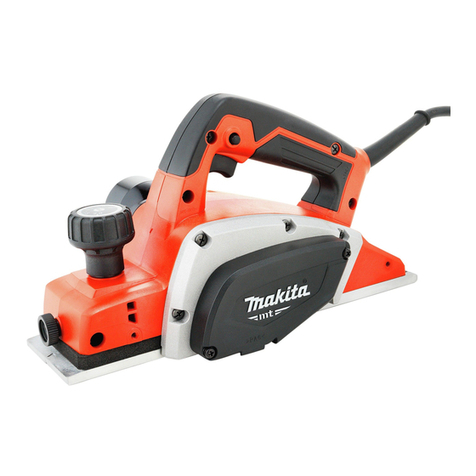
Makita
Makita MT M1901 technical information
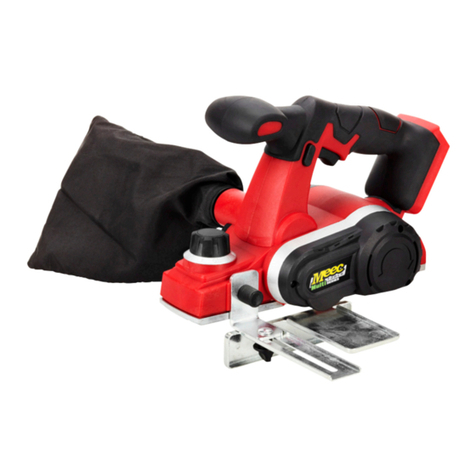
Meec tools
Meec tools Multi Series operating instructions
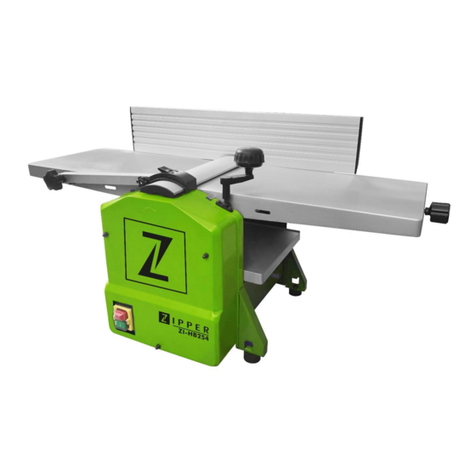
Z.I.P.P.ER MASCHINEN
Z.I.P.P.ER MASCHINEN ZI-HB254 user manual
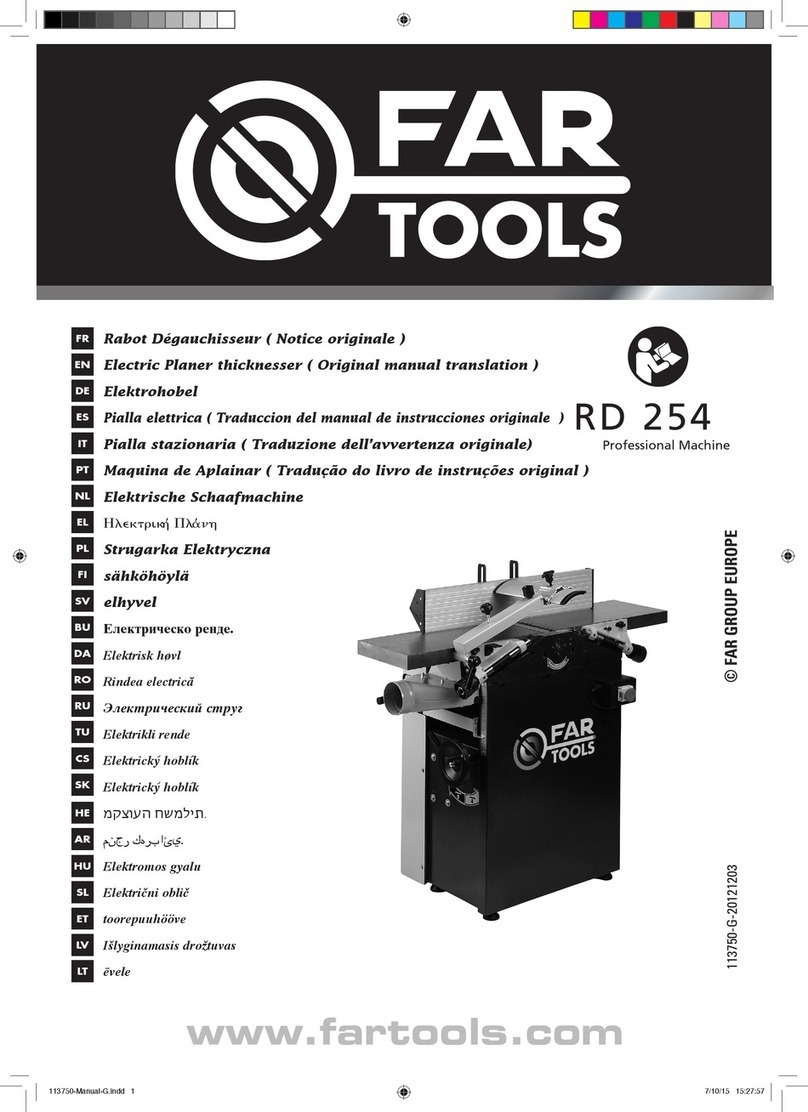
Far Tools
Far Tools RD 254 manual
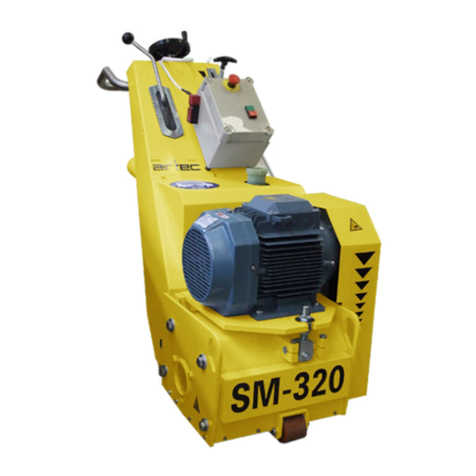
Air TEc
Air TEc ROTO-MASTER SM-320-EL Original-Instruction Manual Spare Parts List
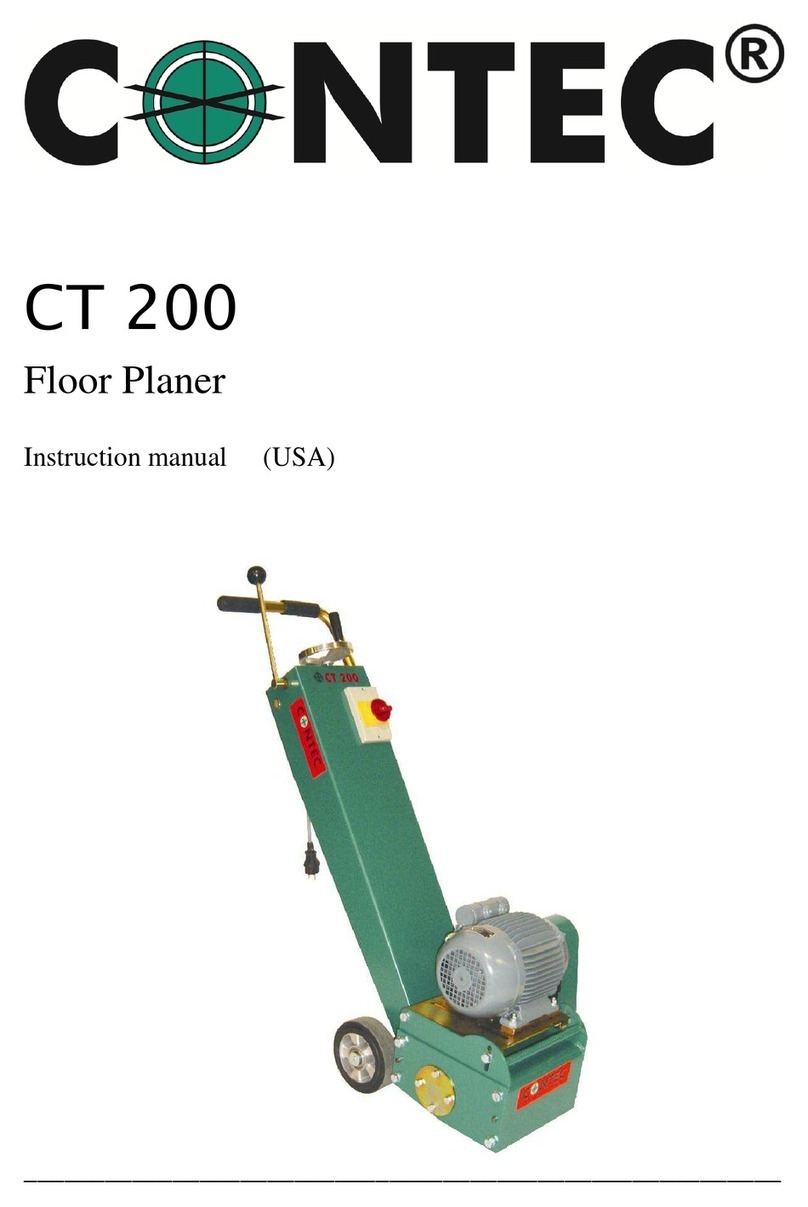
Contec
Contec CT 200 instruction manual
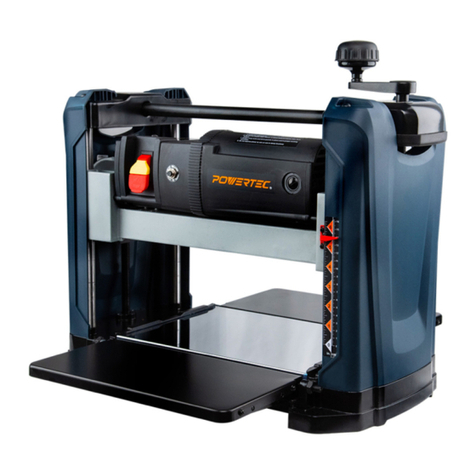
Power Tec
Power Tec PL1252 owner's manual
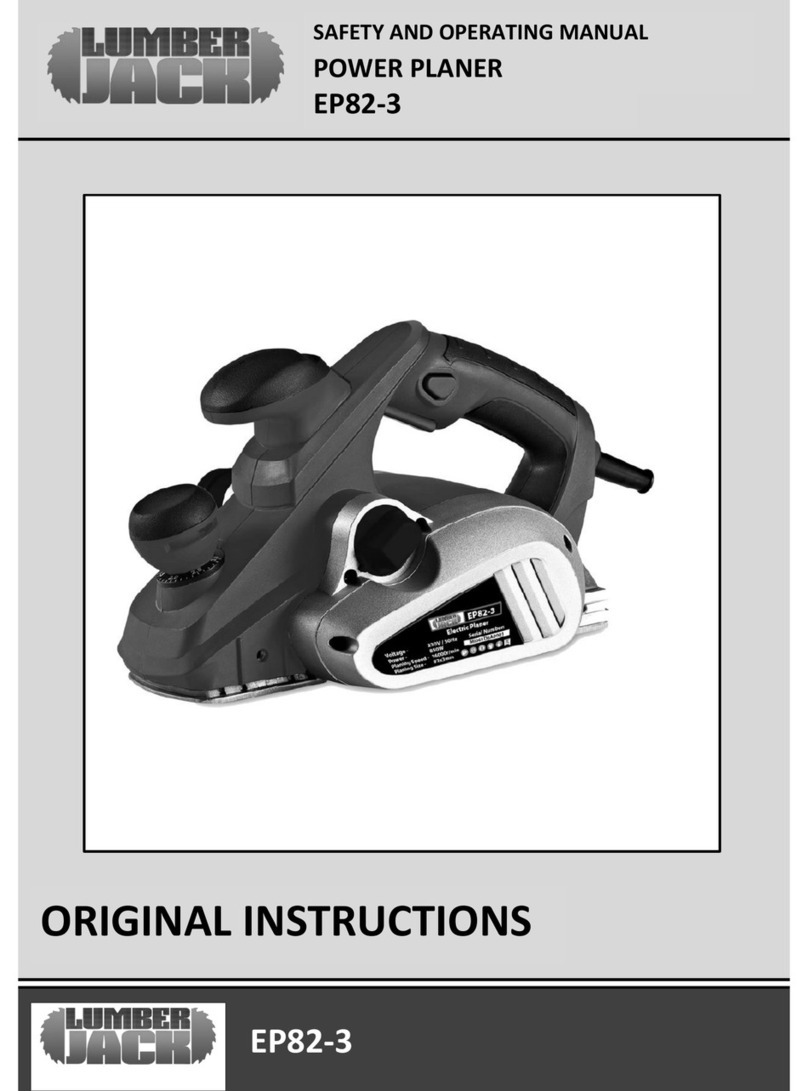
Lumberjack
Lumberjack EP82-3 Safety and operating manual
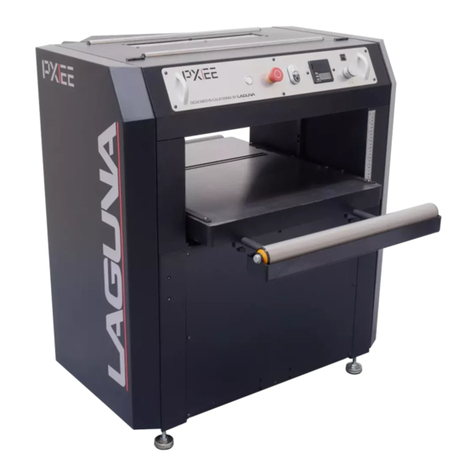
Laguna Tools
Laguna Tools Tools-PX-22 SHEARTEC II owner's manual

King Industrial
King Industrial KC-240M instruction manual

Powermatic
Powermatic 15S Operating instructions and parts manual

Makita
Makita CURVED PLANER 1001 instruction manual

